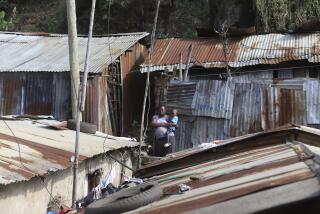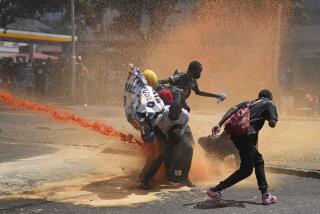Horrifying images on social media fuel tension after Kenya’s disputed election, but not all are real
- Share via
Reporting from Nairobi, Kenya — As protests erupted after Kenya’s disputed presidential election, horrifying photographs and videos flashed across social media: a boy terrified by riot police in a Nairobi slum, a vehicle in flames and a bloodied man with a military boot on his neck.
Some of the images were genuine, but others failed a basic check: a reverse image search on Google.
The terrified boy was photographed in 2008 during ethnic violence that swept across the country after another disputed election in 2007, killing an estimated 1,500 people.
The man with the military boot on his neck was stabbed and killed by soldiers in the Central African Republic in 2014.
And there have been no credible reports of protesters attacking and burning vehicles in recent days.
In a tinderbox atmosphere, where opposition supporters are convinced that their candidate, Raila Odinga, was cheated of victory in last week’s presidential election, the images spread on social media are incendiary.
Whirling conspiracy theories are propelled by opposition claims that the election was rigged in favor of the incumbent president, Uhuru Kenyatta, who won by a margin of 1.4 million votes, according to results released by the Independent Electoral and Boundaries Commission.
The country’s authorities have warned that Kenyans who post images of bodies on social media could face prosecution for inciting violence.
“We urge all Kenyans to avoid recirculating photos that are not verified as real,” said police spokesman George Kinoti. “They are being used to incite and undermine our security.”
But there are reasons why many Kenyans are quick to believe what they see on social media. The police service has a record of using excessive force against protesters, including live ammunition, according to human rights groups. That coupled with the mistrust many Kenyans feel for the nation’s governing institutions adds fuel to the rumors.
Police spokesmen have denied accusations by witnesses and human rights groups that riot police fired live ammunition at protesters in recent days, although spent cartridges were recovered from some slum districts.
At least 24 people were shot dead and dozens more wounded, according to human rights observers. There are also reports of police harassing foreign and Kenyan journalists who were covering opposition protests.
Kenya’s main opposition alliance contends that the election results were falsified in a conspiracy between the electoral commission and the Jubilee political alliance led by Kenyatta. It has also accused authorities of killing 100 people and secretly disposing of the bodies, and it has alleged that members of a notorious criminal gang called Mungiki were sent into Kenyan slums to kill opposition supporters.
Opposition officials have not provided evidence to support their claims and have said they won’t be pursuing their accusations in court.
But several developments have fueled public suspicion, including the torture and killing of a key electoral official days before the Aug. 8 vote, a police raid on an opposition election center and the deportation of two foreign advisors employed by the opposition to help ensure a fair vote.
An American working for the Kenyan opposition describes his harrowing abduction and deportation »
The electoral commission initially denied opposition claims that its computers had been hacked, then acknowledged there had been an attempt to do so, although officials said it failed.
The circulation of false images on social media risks igniting ethnic tensions in a nation where political allegiances divide mainly along ethnic lines.
But social media can also act as a check on abuses, human rights advocates say, allowing private citizens to document violence in volatile slum districts that may be inaccessible to journalists, especially at night.
The Kenya National Commission on Human Rights, which reported that 24 people were killed by police, has urged Kenyans to report election violence, including by posting photos and videos online.
Murithi Mutiga, an analyst with the International Crisis Group, said the circulation of false images purporting to show election violence had increased in recent days.
“It can be argued that fake news in the lead-up to the elections was just aimed at boosting political support,” he said. “Now, when it’s a question of life or death, it’s much more dangerous.”
Mutiga said some of the images shared on social media made people afraid to leave their houses or go to work.
Abbas Gullet, secretary-general of the Kenya Red Cross Society, said that while there had been a surge in violence in Kenya, he too had noticed an increase “in what we call fake news.”
“I hope common sense will prevail, and we will respect one another and at the same time be honest and not peddle incidents that are not true,” Gullet said.
The alienation of opposition supporters stems in part from decades of ethnic favoritism and exclusion. Kenya’s government has been dominated by the Kikuyu and Kalenjin people since independence from Britain in 1963.
In his first term as president, Kenyatta, a Kikuyu, awarded top government and civil service posts mainly to Kikuyus and Kalenjins, cementing ethnic grievances. Odinga, his rival, is a Luo.
“There’s no question that Kikuyus and Kalenjin elites took the biggest share of the pie,” Mutiga said. “The fact so many people are willing to accept Odinga’s complaints shows it’s not just about the election, but abut a sense of belonging and exclusion.”
“I think trying to be more inclusive is going to be a big challenge of Kenyatta, if he’s going to have a smoother second term,” Mutiga said.
Twitter: @RobynDixon_LAT
More to Read
Sign up for Essential California
The most important California stories and recommendations in your inbox every morning.
You may occasionally receive promotional content from the Los Angeles Times.










